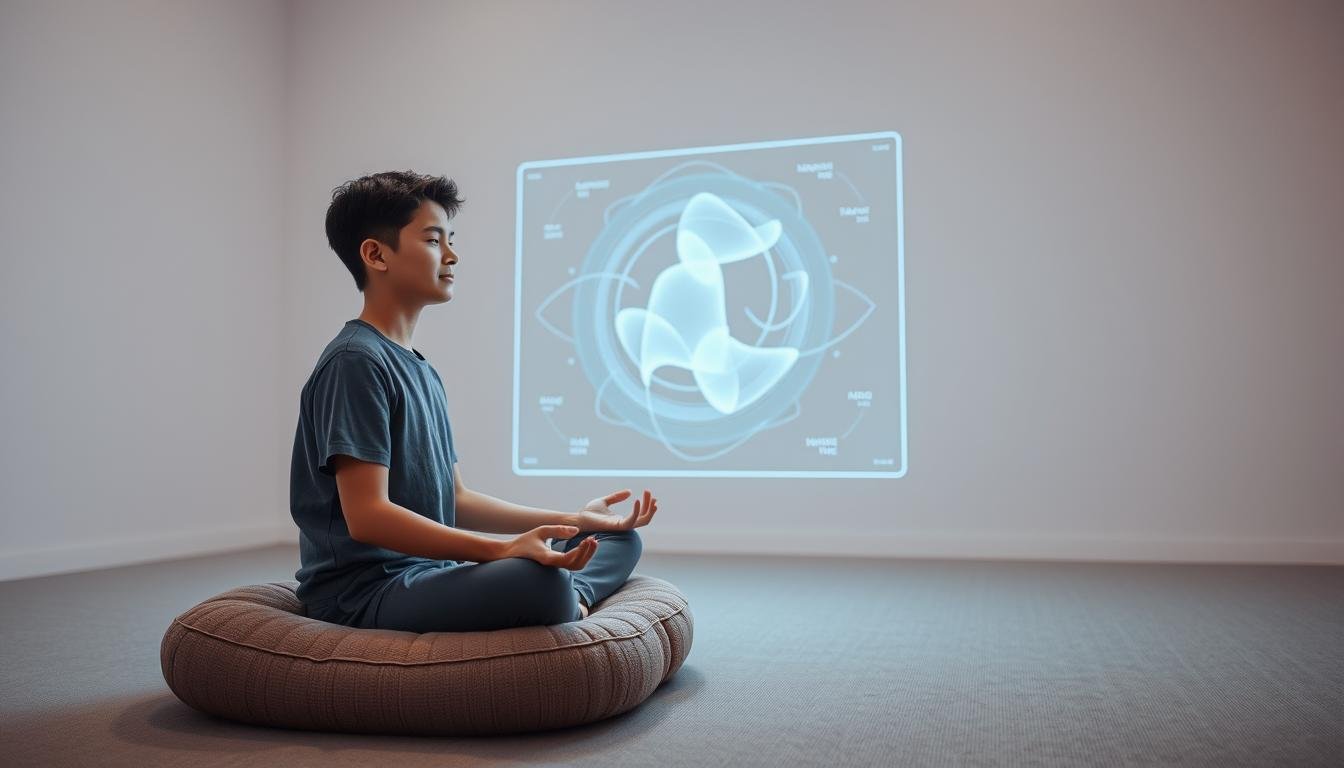Unlock AI-Powered Mindfulness for Students
Balancing coursework, social life, and personal growth can feel overwhelming. Technology now offers a fresh approach to managing these challenges. Imagine tools that adapt to your emotions and schedule, providing calm moments exactly when needed.
Since the pandemic, digital wellness resources have become essential. They help learners build self-awareness and tackle stress without disrupting routines. Customized practices—like breathing exercises or reflection prompts—fit naturally into packed days.
These innovations blend time-tested techniques with real-time personalization. For example, an app might suggest a grounding activity before exams or adjust session lengths based on energy levels. This flexibility keeps practices engaging and effective.
Key Takeaways
- Personalized digital tools adapt to emotional needs and schedules
- Post-pandemic mental health support prioritizes accessibility
- Tech-enhanced practices improve concentration and emotional balance
- Brief daily sessions build resilience without overwhelming users
- Hybrid approaches merge traditional methods with modern convenience
Understanding the Role of AI in Enhancing Mindfulness
Modern solutions for mental wellness now adapt to individual needs like never before. By analyzing patterns in behavior and environment, digital platforms create tailored experiences that grow with users. This approach helps individuals build habits that fit their unique lifestyles.

Custom-Tailored Meditation Journeys
Platforms like Headspace now use smart algorithms to adjust sessions based on mood and stress signals. For example, if someone feels anxious before a presentation, the app might recommend a 5-minute breathing exercise. These systems learn from daily interactions, refining suggestions over time.
Why Digital Support Stands Out
Emotional support chatbots provide instant help through proven techniques. Wysa combines quick check-ins with guided exercises, while Youper tracks progress through mood journals. Key advantages include:
- Real-time adjustments based on heart rate or sleep data
- Session lengths that match energy levels
- 24/7 access to grounding activities
These innovations make traditional methods more accessible. Instead of rigid schedules, users get support exactly when needed—whether during a study break or late-night stress.
Getting Started with a Mindfulness Routine for Students
Healthy routines thrive on simplicity. Short, consistent activities create lasting change better than occasional long sessions. Start with 2-3 minute exercises during natural breaks—like before checking phones or switching study topics.

Step-by-Step Integration in the Classroom
Morning check-ins set a calm tone. Try “weather reporting”—students describe their mood as sunny, cloudy, or stormy. Follow with a 60-second 4-7-8 breathing exercise (inhale 4 counts, hold 7, exhale 8). This regulates heart rates before tests or group work.
Simple Practices to Reduce Stress and Improve Focus
Midday resets combat afternoon slumps. The five-senses scan works well: name one thing you hear, see, touch, taste, and smell. It takes 90 seconds and sharpens attention. For restless learners, suggest mindful walking—counting steps while noticing body movements.
| Technique | Time Needed | Best For |
|---|---|---|
| 4-7-8 Breathing | 1 minute | Test anxiety |
| Five-Senses Scan | 90 seconds | Focus recovery |
| Mindful Walking | 3 minutes | Physical restlessness |
Adjust approaches based on needs. Kinesthetic learners might prefer stretching breaks with breath awareness. Always offer choices—some thrive with silence, others prefer guided audio. The goal: make mindfulness practices feel natural, not forced.
Implementing AI mindfulness for students
Educational environments thrive when mental wellness tools align with learner diversity. The right resources blend flexibility with security, adapting to unique circumstances while protecting sensitive information.

Selecting the Right Apps and Tools
Effective platforms prioritize three features: interactive elements, actionable feedback, and strict privacy controls. Look for tools that adjust activities based on real-time input—like shorter sessions when attention wanes or culturally relevant imagery during guided sessions.
| Feature | Importance | Example |
|---|---|---|
| Two-way engagement | Maintains interest | Quizzes that adjust difficulty |
| Progress tracking | Shows growth | Weekly emotion charts |
| Encrypted data | Protects privacy | Anonymous user profiles |
| Tech compatibility | Simplifies use | Google Classroom integration |
Customizing Practices to Meet Diverse Needs
One size rarely fits all. A child processing grief might receive gentle nature sounds instead of spoken guidance. Teachers can request chatbots to generate visual storyboards for learners who think in pictures or scripted dialogues for role-playing scenarios.
Practical adjustments include:
- Offering multiple language options
- Providing text-to-speech for dyslexic users
- Creating movement-based exercises
These approaches ensure every individual finds supportive practices. Regular check-ins help refine selections, keeping strategies fresh and relevant.
Incorporating Immersive and Interactive Learning
Emerging technologies are reshaping how learners connect with their inner world. Virtual environments now offer dynamic spaces where calm and concentration flourish naturally. These innovations turn abstract concepts into tangible experiences through sensory engagement.
Leveraging VR and AR for a Deeper Experience
Platforms like TRIPP demonstrate the future of mental wellness training. Their systems analyze heart rate and facial expressions to modify digital landscapes in real time. A user feeling restless might find their virtual forest glowing warmer colors, while someone calm could see rippling water patterns intensify.
“These tools help learners visualize their emotional states, making abstract feelings easier to manage,” notes a middle school teacher from Ohio.
| Technology | Key Feature | Learning Impact |
|---|---|---|
| Virtual Reality | Full environmental control | Deepens emotional regulation |
| Augmented Reality | Overlays digital elements | Enhances real-world focus |
| Mixed Reality | Blends physical/digital | Boosts creative problem-solving |
Engaging Activities to Promote Present-Moment Awareness
Simple augmented reality apps transform classrooms into interactive zones. Students might “grow” digital trees by maintaining steady breathing or collect stars by naming emotions accurately. These gamified methods build concentration without feeling like traditional exercises.
Multi-sensory approaches work best. Haptic feedback gloves simulate textures during grounding exercises, while spatial audio guides attention during reflection. Educators report higher participation rates when combining movement-based tasks with breath-counting challenges.
Overcoming Challenges and Maximizing Benefits
Implementing new approaches often brings both hurdles and opportunities. Schools exploring tech-enhanced strategies need practical solutions for smooth adoption while protecting sensitive information. Let’s explore how to navigate common roadblocks while amplifying positive outcomes.

Addressing Technical Integration and Resistance
Technical hiccups can stall progress. Slow internet speeds might disrupt app-based sessions, while outdated devices struggle with newer platforms. A California district solved this by running pilot programs with IT teams on standby. They also created offline alternatives like printable breathing guides for unreliable connectivity days.
Educator skepticism often stems from unfamiliarity. One middle school hosted “demo days” where teachers tested tools alongside developers. Seeing how apps adapt exercises based on heart rate data changed perspectives. As a math teacher noted, “It’s not replacing traditional methods—it’s enhancing them with real-time insights.”
Ensuring Data Privacy and Continuous Improvement
Protecting personal information remains critical. Schools should prioritize platforms with:
- End-to-end encryption for all user interactions
- Anonymous participation options
- Clear data retention policies
Regular updates keep tools effective. A Texas district reviews program metrics quarterly, adjusting session lengths based on engagement patterns. They also gather student feedback through quick polls—ensuring practices stay relevant as needs evolve.
Training bridges the gap between potential and results. Workshops showing how to pair tech tools with group discussions help educators feel prepared. Starting small—like 10-minute Friday sessions—builds confidence over time while demonstrating measurable stress reduction.
Conclusion
The evolution of mental wellness tools brings unprecedented opportunities for personal growth. Emerging technologies like brain-sensing wearables and responsive apps refine traditional meditation practices, offering real-time adjustments to emotional states. These innovations meet diverse needs while preserving the core benefits of breath-focused techniques.
Future developments could see virtual guides adapting exercises based on biometric feedback during stressful moments. Smart reminders might suggest grounding activities before high-pressure tasks, blending seamlessly into daily life. However, human connection remains vital—tech should amplify, not replace, expert-led support.
As these tools evolve, maintaining privacy standards and equitable access becomes crucial. Schools must prioritize secure platforms that address anxiety without compromising data safety. When balanced thoughtfully, tech-enhanced strategies can reduce stress while nurturing lifelong resilience.
Educators and learners alike stand at an exciting crossroads. By embracing both innovation and tradition, we create inclusive environments where everyone thrives.
FAQ
How can technology adapt meditation to fit individual preferences?
Apps like Headspace or Calm use algorithms to adjust session lengths, themes, and guidance styles based on user feedback. For example, if a learner feels overwhelmed, the tool might suggest shorter breathing exercises or calming soundscapes.
What are practical ways to introduce stress-reduction habits in schools?
Start with 5-minute guided sessions during homeroom or before exams. Tools like Smiling Mind offer age-specific programs, while simple practices—like focused breathing or gratitude journaling—can be woven into daily routines without disrupting schedules.
Which features matter most when choosing a focus-enhancing app?
Look for customizable timers, progress tracking, and offline access. Insight Timer and Breethe stand out for their library of teacher-approved content and options to tailor sessions for group activities or solo use.
Can immersive tools like VR truly help with staying present?
Yes! Apps like Tripp or Guided Meditation VR create environments—like forests or beaches—that reduce distractions. These experiences engage senses deeply, making it easier to practice awareness during study breaks or high-pressure moments.
How do educators address privacy concerns with digital wellness tools?
A> Schools often partner with platforms like Stop, Breathe & Think that comply with FERPA and COPPA. Always check for encryption, anonymized data collection, and clear privacy policies before adopting any tool.
What if learners resist using new stress-management methods?
Start with low-pressure options, like ambient noise playlists on Spotify or quick stretching videos on YouTube. Pairing tech with analog activities—like doodling or walking—helps ease transitions and builds trust in the process.
Share this content:




Post Comment